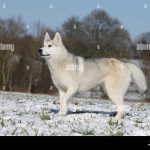When we think of Huskies, we often envision happy, energetic dogs with piercing blue eyes and a fluffy coat, pulling their owners through the snowy wilderness on dog sleds. But beneath this idyllic image lies a harsh reality: many Huskies have experienced abuse and neglect, leaving them with emotional scars that can last a lifetime.
Why it matters
As animal lovers, we often ask ourselves why we should care about the behaviors exhibited by abused Huskies. The answer is simple: understanding these behaviors can help us better rehabilitate and rehome these dogs, giving them a second chance at a happy life.
The effects of abuse on Husky behavior
One of the most common behaviors exhibited by abused Huskies is fear-based aggression. This can manifest in various ways, such as growling, snapping, or even biting when they feel threatened or cornered. But why does this happen? The answer lies in the dog’s past experiences.
When a Husky is abused, it often leads to a breakdown in their trust and confidence in humans. As a result, they may develop a “fight or flight” response, making them more likely to lash out when they feel threatened or scared. This behavior can be challenging to overcome, but with patience, consistency, and positive reinforcement training, it is possible to help these dogs feel safe and loved once again.

When we think of Huskies, we often envision happy, energetic dogs with piercing blue eyes and a fluffy coat, pulling their owners through the snowy wilderness on dog sleds. But beneath this idyllic image lies a harsh reality: many Huskies have experienced abuse and neglect, leaving them with emotional scars that can last a lifetime.
Why it matters
As animal lovers, we often ask ourselves why we should care about the behaviors exhibited by abused Huskies. The answer is simple: understanding these behaviors can help us better rehabilitate and rehome these dogs, giving them a second chance at a happy life.
The effects of abuse on Husky behavior
One of the most common behaviors exhibited by abused Huskies is fear-based aggression. This can manifest in various ways, such as growling, snapping, or even biting when they feel threatened or cornered. But why does this happen? The answer lies in the dog’s past experiences.
When a Husky is abused, it often leads to a breakdown in their trust and confidence in humans. As a result, they may develop a “fight or flight” response, making them more likely to lash out when they feel threatened or scared. This behavior can be challenging to overcome, but with patience, consistency, and positive reinforcement training, it is possible to help these dogs feel safe and loved once again.
Another common behavior exhibited by abused Huskies is separation anxiety. This can manifest in destructive behaviors such as chewing, digging, or barking excessively when left alone. This behavior is often a result of the dog feeling abandoned or rejected, leading to feelings of loneliness and insecurity.
It’s also not uncommon for abused Huskies to exhibit attachment disorders, where they become overly clingy or dependent on their owners. This can be due to the dog’s past experiences of being left alone or neglected, leading them to seek constant attention and reassurance from their new owners.
Rehabilitating an abused Husky requires a deep understanding of these behaviors and the need for patience, consistency, and positive reinforcement training. By recognizing the signs of abuse and providing a safe and loving environment, we can help these dogs overcome their emotional scars and thrive in their new homes.
In addition to physical rehabilitation, it’s also important to provide abused Huskies with emotional support and validation. This can be achieved through gentle touch, soothing voices, and plenty of praise and rewards for good behavior.
Learn more about the effects of abuse on dogsWhat’s next?
In our next section, we’ll explore the importance of socialization in rehabilitating abused Huskies. From introducing them to new people and environments to teaching basic obedience commands, socialization plays a crucial role in helping these dogs feel confident and secure in their new homes.
Get Expert Guidance on Caring for Abused Huskies
Are you concerned about the behaviors exhibited by an abused Husky? Our expert dog care specialists are here to help.
Get Expert Dog Care AdviceIn our previous article, we explored the behaviors exhibited by abused Huskies, including fear-based aggression. As we concluded, understanding these behaviors is crucial for rehabilitating and rehoming these dogs, giving them a second chance at a happy life.
Summarizing the key points
We’ve seen how abuse can lead to a breakdown in trust and confidence in humans, causing Huskies to develop a “fight or flight” response. This fear-based aggression can manifest in various ways, including growling, snapping, and biting. However, with patience, consistency, and positive reinforcement training, it is possible to help these dogs feel safe and loved once again.
Final insights
The journey of rehabilitating an abused Husky is not an easy one. It requires dedication, understanding, and compassion. But the rewards are well worth the effort. By recognizing the behaviors exhibited by abused Huskies and working to address them, we can help these magnificent creatures heal and thrive once again.
Conclusion
As we close this article, let us remember that every Husky deserves a second chance at life. Whether they’ve been rescued from a shelter or are still living with their original owners, abused Huskies need our help to overcome the trauma of their past. By providing them with love, care, and rehabilitation, we can give these dogs a fresh start and a brighter future. So let us continue to work towards creating a world where every Husky can live a life free from abuse and filled with joy, love, and adventure.
1 urine protein: understanding its significance: Have you ever wondered what it means when your urine contains protein? Our comprehensive article explains the importance of urine protein levels, how to test for it, and what it can indicate about your overall health. Click to discover more!
The best dog for a single female living in an apartment: Are you a single female looking for the perfect furry companion to brighten up your apartment life? Our expert guide reveals the top breeds that are ideal for small spaces, low-maintenance care, and endless love. Click to find out which breed is purr-fectly suited for you!



